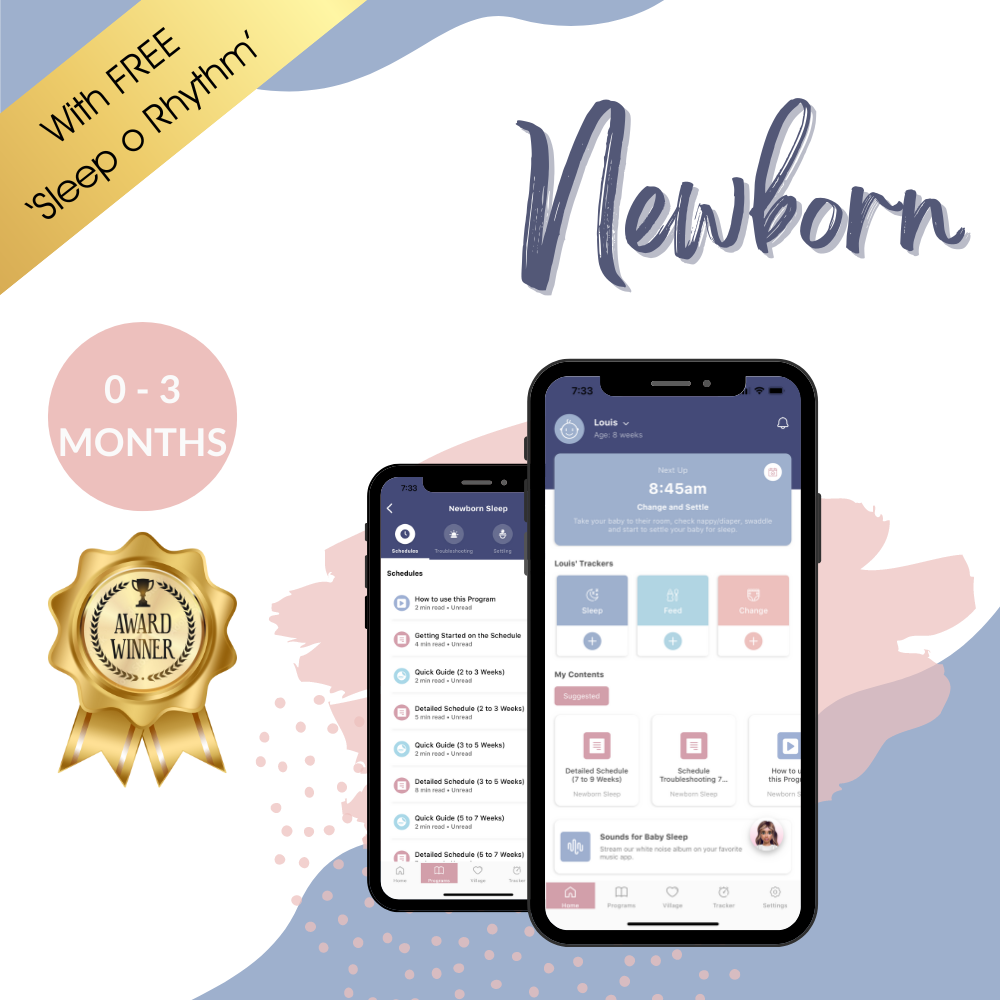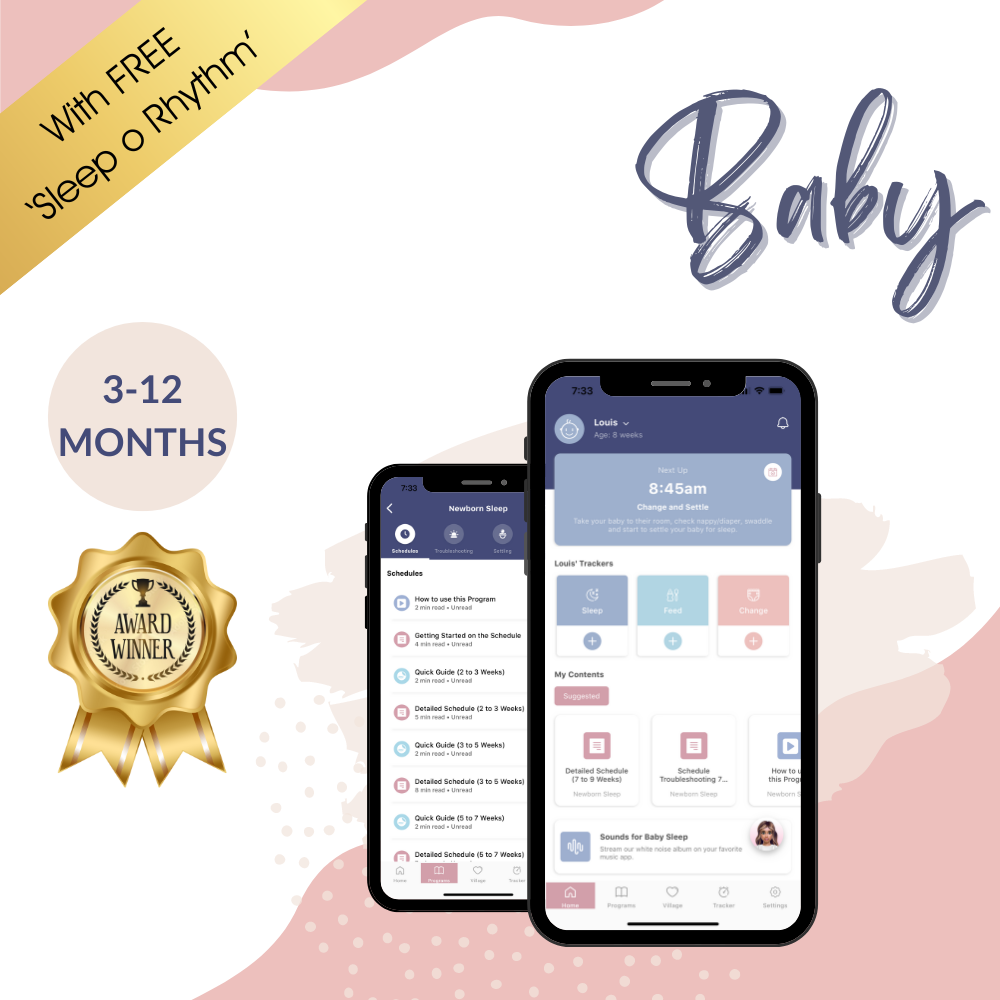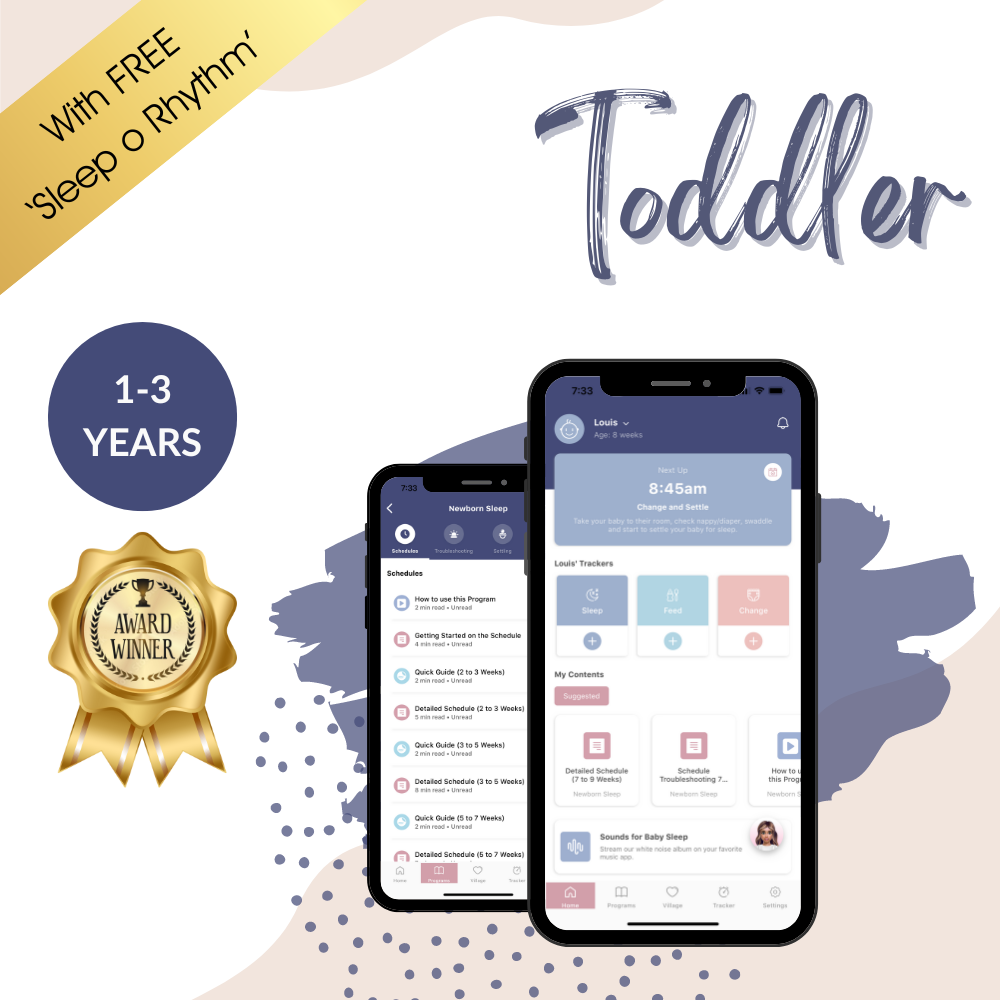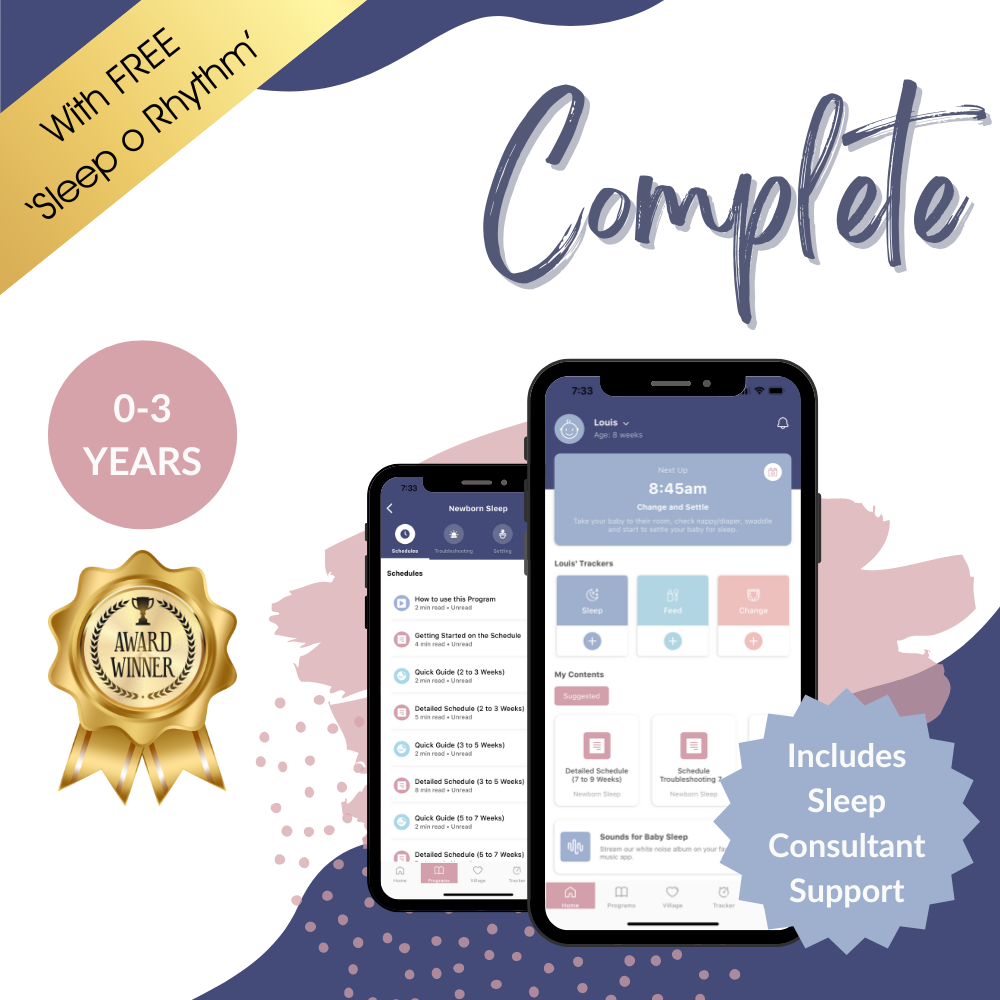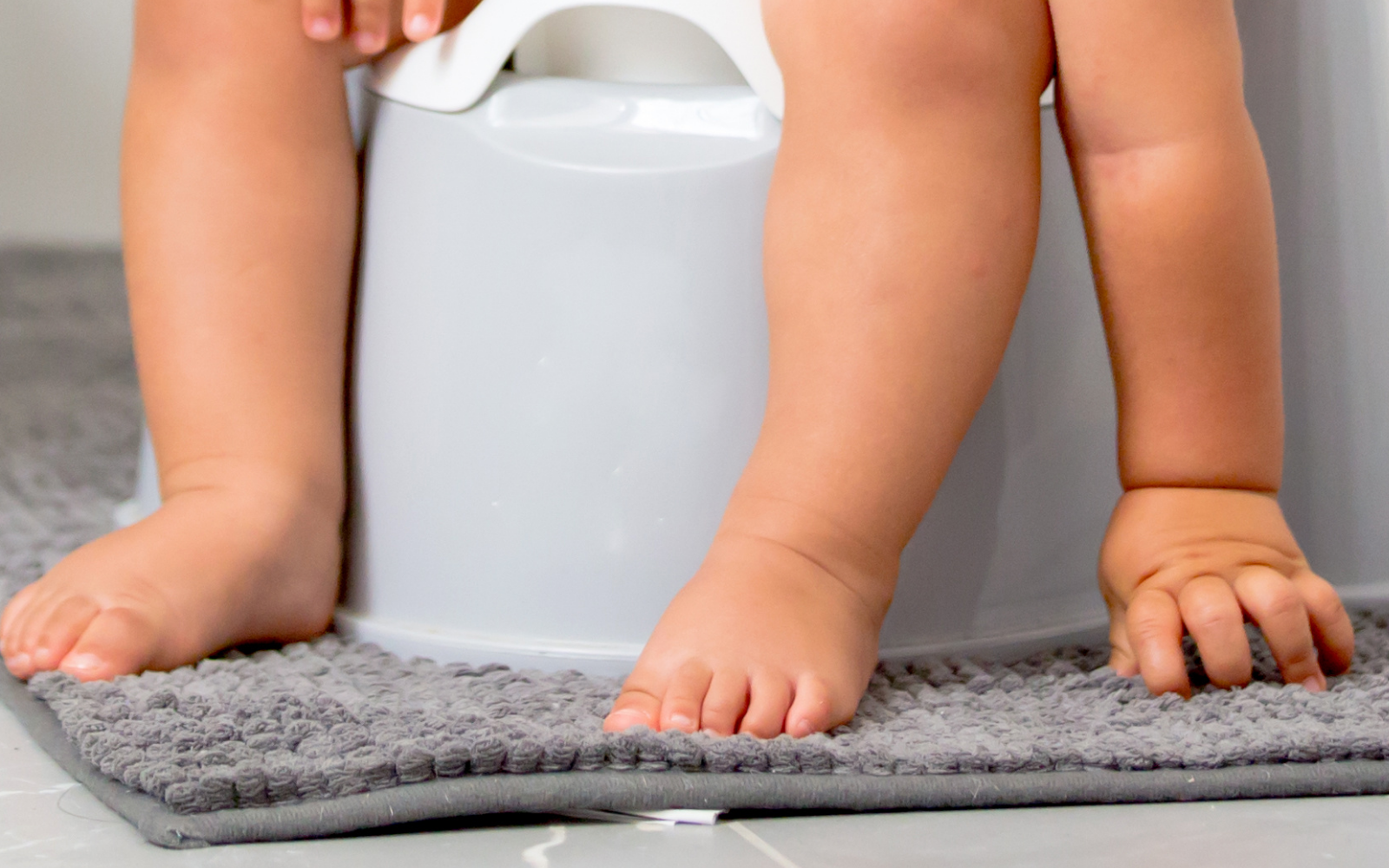
Toilet Training and Sleep
Most parents eagerly anticipate the day when they can finally say goodbye to nappies, but the idea of toilet training, or potty training, can seem quite daunting for some. If you get the timing right though, toilet training can actually be a pretty straightforward process.
Even once your child is managing to stay dry during the day though, it can be a while before they are able to do that overnight. In this article, we will explain how to approach both daytime and nighttime potty training and provide some tips that will help to set your child up for success.
Our Little Ones App contains more detailed advice around toilet training and sleep, including our ‘‘Toilet Train in Under a Week’ guide. You will also have the option to access our certified sleep consultants in the Little Ones Village, who can guide and support you through the toilet training process.
What is the best age to start potty training?
Most children will be ready to start daytime toilet/potty training somewhere between the ages of 2 and 3 years. When deciding whether or not your child is ready to start potty training, the main factors to consider are:
- Speech development – your child can communicate to you that they need to use the toilet or when they have done a wee or poop in their diaper. They will also be able to understand and follow simple instructions.
- Physiological development – your child can sense when they are actually weeing or pooping (or when they are about to) and can control this to a degree. They will also be competent enough to sit on the potty or toilet by themselves.
- Cognitive development – your child has started to show an interest in the toilet or in watching other people use the toilet. Some children will also start to remove their own diapers if they are wet or dirty now. They will also have a basic understanding of effort and reward and respond positively to praise.
E-Book: Navigating the Preschool Years: Sleep, Behavior & Development for 3 to 6 Year Olds
There is a LOT of growth and development that happens between the ages of 3 and 6 years and your child becomes a pretty amazing, pretty independent little human. There can also, however, be a raft of challenges that accompany these changes (and I know I don't have to tell you that!).
In our comprehensive e-book we'll guide you through your little one's sleep, behaviour and development across these crucial years.
Buy Now
How do I start potty training during the day?
Before you get started, you’ll want to make sure you are prepared with the following items:
- Potty or toilet training seat.
- Toilet training picture books - we recommend reading these with your child before you get started
- LOTS of fun underpants - let your child pick out their favourite colours or characters
- Sticker chart with stickers
- Pull-up nappies/diapers for naps and overnight sleep.
Once you are ready to get started, we recommend the following:
- When they wake, remind them that they’re going to learn to use the potty today. If the weather allows, dress them in a shirt only - no pants or underwear.
- Teach them a phrase to use when they need to go to the toilet and give them plenty to drink throughout the day so that they have lots of opportunities to practise!
- The first wee on the potty is the most important, as this lays the foundation for the rest of the toilet training process. The more happy and excited you are, the more they’ll want to repeat that behaviour to please you again.
- For the first day, don’t let them out of your sight. They may not tell you when they’re about to wee initially, so you’ll have to watch for signs that they need to go and then quickly sit them on the potty or toilet.
- For every wee they do in the potty or toilet, act excited and put a sticker on their chart as a visual reminder of their success. If they have an accident, don’t make a big fuss, just clean it up and continue with your day.
- By the end of the first day, they should have done lots of wees on the potty and should be starting to identify when they need to go. Some children will even start to take themselves off to the potty now.
- At their nap and bedtime, continue to use a pull-on nappy/diaper and reassure them that it’s okay if they do a wee while they are sleeping. Start to get into the routine of going to the potty before their nap and bedtime.
Our ‘Toilet Train in Under a Week’ guide contains more detailed advice about daytime toilet training, including doing poos on the potty, dealing with potty/toilet resistance and managing outings while toilet training. This guide is exclusively available within our Little Ones App.
What is the difference between daytime and nighttime potty training?
Many parents assume that once their child is potty trained during the day, the nights will automatically follow. Unfortunately that’s not always the case. Daytime and nighttime toilet training are actually two very different processes.
When your child is awake during the day, you can teach them to go to the toilet, but there’s no way to do this overnight while they are asleep. Your child’s ability to stay dry overnight is largely a biological process, rather than something you can train them to do.
Say goodbye to sleepless nights.
Join over 800,000 families worldwide who are enjoying excellent sleep with our Sleep Programs, created by experts in the field of pediatric sleep.
Get our Sleep Programs
For your child to be able to stay dry overnight, their bladder either needs to be large enough to hold the urine that is produced while they sleep, or their brain needs to be mature enough to wake them when they need to go to the toilet. These developmental milestones can closely follow daytime potty training for some children, but for others it won’t happen for months or even years after they are toilet trained during the day.
What age can you start night time potty “training”?
Although it’s not really possible to “train” your child to stay dry overnight, a good indicator that they may be ready to start wearing underwear to bed is if they are waking up dry in the morning. Or, your child might communicate to you that they no longer want to wear a nappy overnight - in this case, we would recommend you follow their lead.
Ideally, you also want your child to be able to go to the bathroom independently so it can often be a good idea to wait until they have transitioned from the cot to a toddler bed. We generally recommend holding off on that transition for as long as possible though, so if your child isn’t ready for a toddler bed yet, there’s no harm in keeping them in nappies overnight for a bit longer!
How do I potty train my child at night?
If your child is waking dry in the morning or has expressed that they no longer want to wear a nappy overnight, then you can follow these tips for nighttime potty training success:
- Stay consistent with your daytime toilet/potty training
- Limit liquids before bedtime to help prevent accidents overnight
- Make going to the toilet/potty part of your bedtime routine.
- Be prepared for accidents - a mattress protector is a must! To make nighttime bedding changes even easier, I recommend the double-layer method. Put down a mattress protector first, then a sheet over the top and then repeat that again. When your child has an accident overnight, you can simply strip off the first two layers and you’ve got a freshly made bed ready to go!
- Make sure there is a well-lit path to the toilet so that your child feels comfortable getting up to wee overnight.
- If your child does manage to stay dry through the night, give them lots of praise and positive reinforcement!
- If your child is wetting the bed quite frequently, put them back in a pull up nappy or training pants and try again in a few months time.
Should I wake my child up to pee at night?
Another strategy that can help your child to stay dry overnight is to take them for a “dream pee” or “dream potty” before you go to bed. To do this, you would pick your child up and carry them to the toilet while they are still asleep/drowsy. When you pull down their nappy and sit them on the toilet, the familiarity of that should be enough to get things going. If nothing’s happening though, you can try verbally encouraging them to do a wee. When your child is done, pull their nappy up and carry them back to bed.
We would only recommend doing the dream pee if your child is easily resettling back to sleep afterwards. If they are waking fully and then staying up for hours afterwards, leave them to sleep instead!
Can toilet training cause my child to wake more overnight?
Following daytime toilet training, some children will start to wake more overnight because they either need to pee or they have already done a wee in their nappy/diaper and want to be changed. Your child may not be able to communicate why they have woken though.
If their nappy is wet, change them and resettle them back to sleep. If their nappy is dry though, you may want to try putting them on the toilet or potty at that time to see whether they need to go.
If your child is aware that they need to pee and can communicate that to you, it might be time to start working on toilet training overnight - especially if they are reluctant to pee in their nappy/diaper.
When should I be concerned about my child’s bed-wetting?
If your child is still waking wet most mornings or having accidents overnight, especially as they get older, it’s natural to start worrying about whether this is “normal” or not. The truth is, most children aren’t capable of staying dry overnight until closer to 5 years old.
By 5 years old, around 80-85% of children will be staying dry overnight (5). For the remaining 15-20%, a number of factors can contribute to their bed-wetting including genetics, a small bladder or low muscle control. Up until the age of 7 years old, bed-wetting is considered quite normal and isn’t a cause for concern. It is also much more commonly experienced by boys, compared to girls.
It’s also quite normal for your child to regress in their toilet training from time to time - especially when there are big changes in their world like a new sibling, moving house, starting school etc. So even if your child has been dry overnight for a while, it can’t hurt to keep a mattress protector on their bed - just in case!
If your child does have an accident, try not to make a fuss about it. Use the double layer method to quickly change their bed, help them get changed into dry PJs and then pop them back into bed and say goodnight. Although bed-wetting can be frustrating, it’s important to remember that this is something beyond your child’s control and it will improve as they get older.
Let's get your little one's sleep sorted ASAP!Our award-winning Sleep Programs will solve your baby's sleep challenges in no time.
Get our Sleep Programs
If your child is still wetting the bed after 7 years old, or if they begin wetting the bed suddenly after months of being dry overnight, it would be a good idea to discuss this further with your doctor.
For more detailed advice about toilet training and sleep, make sure to check out the ‘Toilet Train in Under a Week’ guide within our Little Ones App.
___________
Bibliography
Donaldson-Evans, C. (2015, January 28). Nighttime Potty Training and Bed Wetting. What to Expect. https://www.whattoexpect.com/toddler/behavior/bed-wetting.aspx
Harvard Health (2018, November 25). Bedwetting (Enuresis). Harvard Health. https://www.health.harvard.edu/a_to_z/bedwetting-enuresis-a-to-z
Health Direct (2022, January 4). Toilet training. Healthdirect Australia. https://www.healthdirect.gov.au/toilet-training
NHS Choices. (2022). How to potty train. https://www.nhs.uk/conditions/baby/babys-development/potty-training-and-bedwetting/how-to-potty-train/


